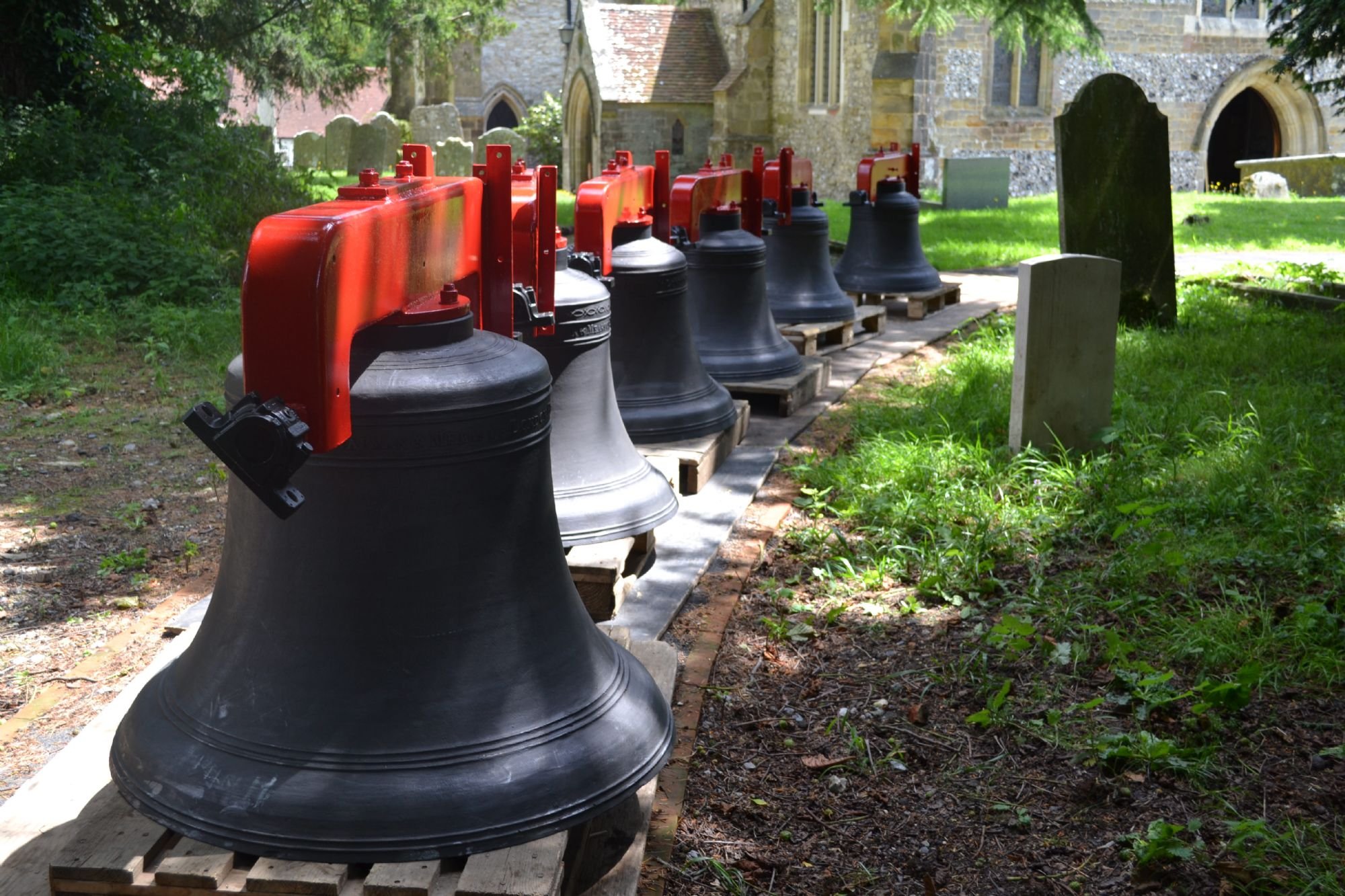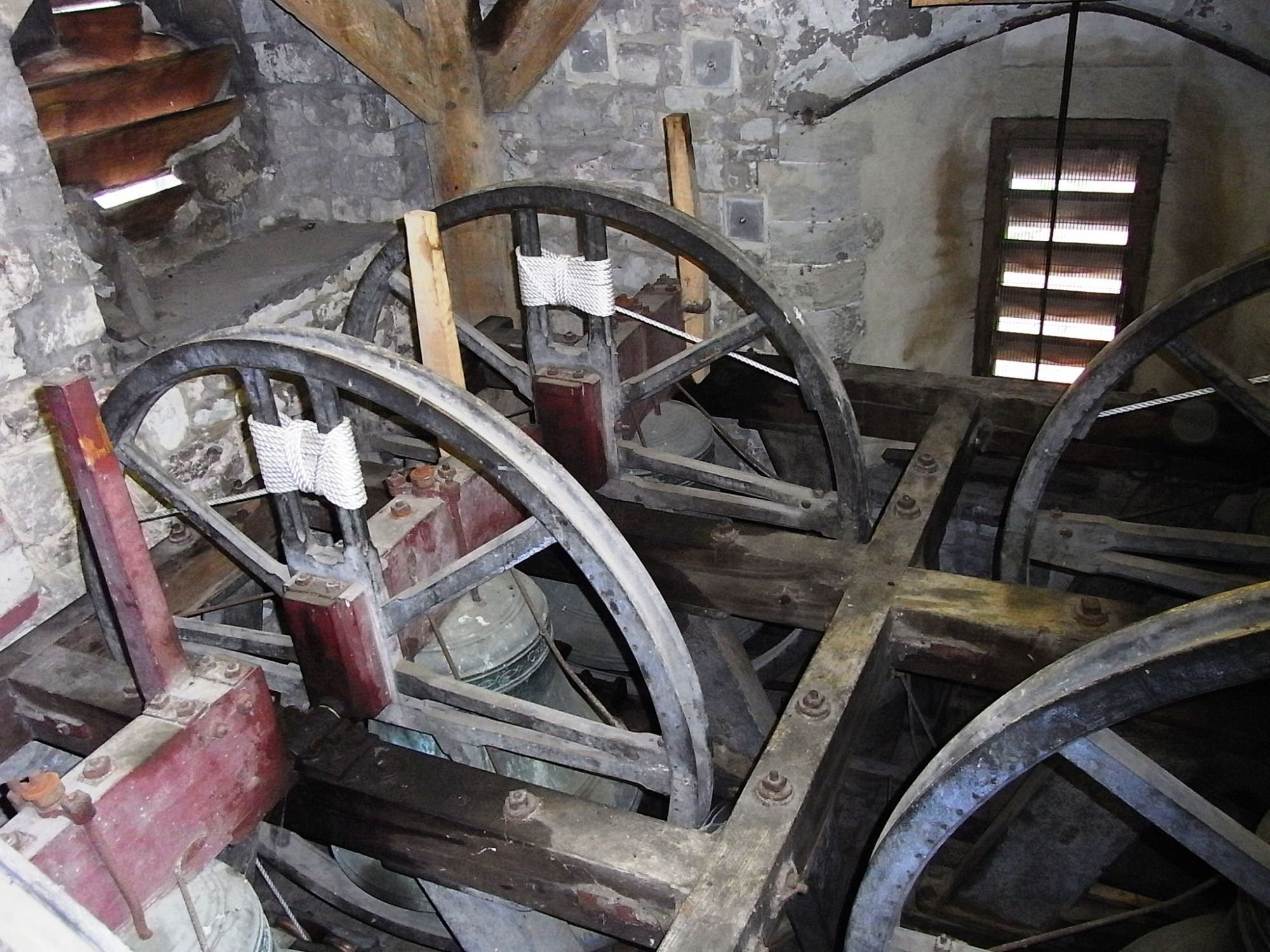
Bells
Harting Bells
A Quarter peal was rung at the church on the 8th May 2023 as part of the Coronation celebrations.
This involved a team of 6 which included two of our ringers (Chis and Luke), regular visitors from Midhurst (Francesco who organised this and his brother Luca) together with two visiting ringers. A quarter peel involves 1260 changes.
Bell Ringers needed
For several years we have been very lucky to have a successful band of ringers in the Harting Parish Church. However, with ringers moving on and others off to University sadly, our numbers have fallen. We urgently need to recruit or find new ringers.
If you would like to 'have a go' please come to our Tuesday evening practice at 7.30pm.
Contact: Patricia James (Secretary ) on 01730 882669
We ring for church services, weddings, national, and even international, events. In 2022 we joined all the parish churches in the country in honour of Her Majesty the Queen’s Platinum Jubilee and rang on muffled bells during the hour before her funeral. We also rang for the Coronation of King Charles III on the 6th May.
Bell Ringing for the Coronation - BBC News item 22nd February 2022
The Rev. H D Gordon records that the four original bells were re-cast in 1782 and two more were cast to make a ring of six. All are marked CHAPMAN & MEARS OF LONDON FECERUNT 1782.
The bells range from a few hundredweight to the tenor bell which, with its headstock, weighs about three quarters of a ton.
Bell Ringing
Many of us have watched our bell-ringers in action, although not all of us are aware of the complex system existing up in the belfry which gives us the joyful sound.
Originally, church bells were rung by a simple pull which started them swinging. There was no method of varying the order in which they sounded.
During the 1500s a mechanism was developed in England whereby bells could be stopped and started at will. This enabled them to be rung in different sequences, hence ‘change-ringing’
The restoration of the Harting bells 2011
THE NEED FOR RESTORATION
In 2009 Geoffrey Rix, the Bells Adviser to Chichester Diocese made a detailed survey of Harting’s bells and belfry having previously viewed them in 1992 and 2004 when no funds were available.He found a number of serious shortcomings wanting urgent improvement and came to the conclusion that the bells had become taxing even to a very experienced band and to the average ringer they were extremely difficult to handle.
He commented :
Wear has occurred in the bearings which carry the bells.The supporting bolts have corroded and can no longer be tightened. There is beetle attack in the treble elm headstock. The worn bushes of the bell clappers show vertical play on some bells. Distortion of the wheels can cause the rope to come off. Worn runner boards add to the friction to be overcome when ringing. The rope pulleys are also badly worn causing additional friction. The hanging radii and wheel diameters are far from ideal. There is movement of the frame which makes for difficulty in ringing. In the arch of the clock chamber there are grooves caused by bell ropes. In all, the increased friction from fittings and bearings and the frame movement results in the effort needed to ring is constantly changing so that accurate striking is a near impossibility.
All of this made the ringing of Harting Bells very challenging for learners and experienced alike
THE BEGINNING
Some preparations were necessary before the bells could be removed.
The horizontal rod which drives the north clock dial was dismantled to allow free movement in the bell chamber. The clock hammers and Ellacombe hammer equipment by the hatch in the bell chamber floor were removed for the hatch to be opened.
This major task started on 21 March 2011 and took three days.The space in the belfry is very restricted and the tenor bell, with its headstock, weighs about three-quarters of a ton. There are few places to stand and there is an open hatchway in the floor which could not be protected. The central hatch in the clockroom floor below was protected by a barrier provided by Nicholsons of Nyewood who also supplied the wooden beams which suspended the hoist.
Releasing each bell and its fittings from the frame, lifting it across the area to the hatch and lowering it down demanded delicacy coupled with brute strength.
The volunteers who helped the professionals from Nicholsons had been recruited in the expectation that there would be an electrically-operated hoist to do some of the donkey work. However, this hoist never materialised. So a lot of the heavy work was borne by Chris Rose (pictured), Richard Dale, Leslie James and Brian Park of South Harting and Nick Witney from West Harting.
The time-honoured chain and pulley system was used. Each heave on the chain lowered each bell a fraction of an inch; 23 feet down from the clock-room meant a lot of heaves.
The tenor bell presented an extra problem. The diameter of the rim - over 41 inches - was greater than the minimum width of the clock-room hatch so this heavy bell had to be tilted to get the rim partly through the hatch first. The rest of the bell could then follow.
In addition to the team from Nicholsons and those mentioned above there were a number who worked hard to make a success of the operation namely Graham Hills of the Sussex Churches Bell Restoration Fund, from The Sussex Association of Bellringers, David Kirkcaldy The Master of the Sussex County Association of Change Ringers, Jo Gush the Tower Captain, Pru Barlow, Chris Rose and Pat James. Below, Humphrey Sladden looks on.
There was relief all round when the six bells were safely down on terra firma,
The Reverend Peter Grigsby blessed them as they departed St Mary and St Gabriel Church on their way to Nicholsons, the bell hangers in Bridport, Dorset.
The bells were then lifted onto a lorry and set off on their restoration journey.
THE RESTORATION WORK AT NICHOLSONS' FOUNDRY
Referring to the report by Geoffrey Rix on the need for restoration, the following work was carried out during the months from April to July 2011.
1. Bearings Only the tenor bell had been fitted with ball bearings previously, the other bells were running in plain gunmetal bearings. New heavy duty double row self-aligning ball bearings housed in cast iron plummer blocks were fitted in new headstocks for all bells.
2. Securing bolts. New bolts of galvanised steel were fitted throughout. Some of these were later replaced by heavier bolts.
3. Headstocks. New hot-dip galvanised steel headstocks were made and fitted to all bells with steel gudgeons and staple adjusting screws for setting and maintaining even clappering.
4. Clappers. New malleable iron clappers with Tufnol bushes with independent crown staples and stainless hinge pin for each bell. Hanging radii corrected.
5. Wheels. New wheels of English oak spokes, ash soles steamed to shape and chestnut shrouds, steel angle braces. Wheel diameters corrected.
6. Runner boards, stays and sliders. New hardwood runner boards, stays and sliders of ash, steel slider pins.
7. Pulleys. New pulley blocks, with the pulleys being manufactured from cast nylon, each running on two sealed ball bearings and housed in hardwood boxes.
8. Hanging radii and wheel diameters. Both corrected under 4 and 5.
9 Bell frame. The whole frame fully tightened and later re-tightened.
Also, the bells were turned to present unworn surfaces to the clapper blows
THE BELLS RETURN
They had been due to return in June but Kevin Vincent of Nicholsons, who makes the headstocks, suffered an injury - not on our project - so the bells eventually came back on 11 July. To save hauling them up the church path the lorry reversed up the lane for them to be unloaded at the upper gate.
How smart they looked with their scarlet headstocks and new plummer blocks!
With the pathway protected from the wheels of the trolley, which carried the bells through the west door, then the really hard work of raising them to the bell chamber began.
This was a heavier task than bringing them down. Valiant volunteers Richard Dale, Leslie James and Brian Park were hard at work for the best part of three days.
The electrically-operated hoist finally appeared after the bells were safely up in the bell-chamber.
Reg McKenzie and Graham Hills worked on the assembly in the bell-chamber, rehanging the bells, refitting the wheels, clappers, pulleys and clock hammers. Geoff Rix, with his technical skills and experience, provided the hands-on management to ensure everything was done correctly.
Once the bells were back in their frames Geoff Rix and Richard Dale worked together for a further three days tightening nuts and making final adjustments under the supervision of Nicholsons' engineer.
On Tuesday 19 July, following a blessing from the Reverend Peter Grigsby, a joyous peal rang out after a silence that had lasted three months.
FINANCE
Work on the bells had been considered necessary in 2004 but funds were not available at the time.
The Friends of Harting Church undertook responsibility for the whole cost of the restoration of the bells estimated to be £29,515 including VAT. However, the VAT regulations altered adversely during the project with the removal of Work to Bells from the Listed Places of Worship Grants Scheme. This meant that the cost of the work increasedby 20% to £36,600,
Fortunately the voluntary effort by the helpers reduced the cost by over £5,000.
Humphrey Sladden applied for grants and The Sussex Churches Bell Restoration Fund contributed £7,000 and The Sharpe Trust £250.
We are extremely grateful to these organisations which gave so generously. The improvement to the bells and to their ease of ringing has been remarkable and ensures their survival for hopefully another hundred years.
ACKNOWLEDGEMENTS
The late John Sladden wrote and published a limited distribution book about the restoration of the Harting bells, from which much of this text has been drawn.
A number of people contributed photographs for the book, chiefly Margaret Dale, Jo Gush and Peter Hayman





























